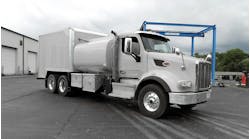DO what you know — not what you want to do.
In “Controlling Maintenance Costs and Managing People in a Challenging Economy,” the Trincon Group's Jim Buchanan said some fleets are best served by having a preventive maintenance (PM)-only capacity.
He said fleets need to know their maintenance costs, and can do it by:
-
Getting software (or other recordkeeping and reporting capability) to identify and break out specific costs by type of equipment.
-
Separating tractor and trailer tire costs. “There's a mix, but sometimes non-asset-based fleets have trailers going to owner-operators and independent contractors,” Buchanan said. “When you separate costs, you're able to identify those things: tractor tires, suspensions, etc. Then you can get costs per mile, hourly rate, and other things that affect you.”
-
Keeping a historical and manufacturer record of MTBF (Mean Time Between Failures — average hours or miles that a component fails) and ECLS (Expected Component Life System — studying fleet maintenance trends and replace before they fail). “If you don't, you really should start,” he said. “There's hundreds of dollars of difference between doing it in the shop and having a tow truck go out and then doing it at a truck stop.”
How many technicians do you really need?
Shop management should consider the factors that limit the amount (and type) of maintenance activities, and the expected production capabilities: hours available, space of the facility, the type of maintenance performed, the age of the fleet, the type of operation (vocational, severe service, etc), and the shop efficiency rate (90%?).
“Some fleets don't really know how many technicians they need,” he said. “This is because of a flux of increase and decrease. Some fleets have experienced an increase in business and are not hiring drivers. They may have laid off mechanics and technicians. But as business increases, those trucks are being used more, and we have to identify how many technicians we really do need. We do that through analysis and comparison. A lot of times, we may have 15 mechanics at a facility. What are they doing? Get into direct and indirect analysis.
“Are they working eight hours a day? Not really. There are things taking away direct labor capability. There are meetings and training time. There's time bringing out tools and putting them away. There's time getting parts. A lot of fleets have taken initiatives, so as they're preplanning, they preorder special parts they don't have in stock and make sure the parts are delivered to mechanics, rather than have mechanics go over and check them out.”
Continued to Page 2
NTTC Cargo Tank Maintenance Seminar...
He said fleets need to determine the average number of hours per fleet vehicle by a historical repair order analysis, giving them a picture of how many vehicles are in operation from year to year.
“This can be done by a tractor, trailer, or component evaluation that identifies the mechanic specialty for the fleet,” he said. “A lot of fleets have specific components on their vehicles — blowers, hydraulic systems, etc — and have specialized people who work on just those components. Or some send it out. You have to look at value to see where your own fleet captures those costs. By knowing the available mechanic hours and the past requirements of the fleet by repair order, an average requirement can be determined.”
Track the following with spreadsheets:
- Labor hours
“Take a look at total labor hours and compare them to shops in your own system,” he said. “Track overtime hours. Do you need more mechanics? Do the analysis. Are you better off to get a mechanic or give more work to one of the mechanics who's really motivated to do the job? Over a period of time, you can determine what processes and procedures are in place to decrease your costs.”
- Work orders
“You have only so many days, hours, and technicians available,” he said. “You have to determine through historical analysis how many work orders you're capable of getting through the shop. By tracking, you can know what the standard is for that shop. Open work orders have to be done within the system you're using to account.”
- Hours absorbed
“If you're assuming a 90% efficiency rate, you have to look at how that actually applies to your fleet,” he said. “PACCAR, International, and some of your better facilities, are set up to be 90-95% efficient. But many fleets are not really that efficient. Many things are going on that deduct from their capabilities, and there are many distractions. Take a look at your hours and where they're going.”
- Capital equipment expenditures
Because it's such a capital-intensive industry, take a look at where tractors are and the reasons they're not in service. Outside of the declining economy the past couple of years, you have to take a look at the assets available. Are there reasons why tractors are in certain locations? What are those locations? Are they in a service facility? Are they wrecked and undergoing service somewhere else? These things have to be reviewed before maintenance managers can make improvements. Track trailers the same way. There will be wrecked trailers, out-of-service trailers, trailers being inspected. Trailers are going to be different places, and the fleet must track them and see what's available for asset utilization of the fleet. Operations and maintenance have to work together. By being able to track, managers can see what improvements have been undertaken. They have to identify where costs are going and why.
Tires are a huge expense. New-tire inventory can vary by the position the fleet is in financially to make extensive acquisitions. Some manufacturers are operating incentives for fleets to take on increased new-tire capability. Over the long run, that will help reduce tire costs.
“Is 7 cents a mile good for a fleet? 3? 5?” Buchanan asked. “Once you identify that you believe you have a tire-cost issue, bring in outsiders from your tire manufacturer and have them provide solutions. They are willing to do that because as needs for increased truck acquisitions increase, they're going to want to have their tires spec'd. If they can solve a problem for you, they are looking for you to show loyalty in spec'ing their tires.”
He said if nobody tracks warranty issues, “there's a lot of money left on the table.”
Questions to answer: Who can authorize warranty claims? Is labor covered? What procedure is required to validate a claim? How long will it take to settle a claim? Is this an absolute, or will the vendor work with fleet management? Is it a like exchange, credit to an account, or cash reimbursement?
The keys to warranty tracking: replacement parts vs new vehicle warranty; tagged and recorded, search of in service date; follow manufacturers' changes in warranty time/procedure for claims; warranty module on parts/maintenance systems; follow up for claim resolution.
Continued to Page 3
NTTC Cargo Tank Maintenance Seminar...
He said a lot of fleets have gotten into a longer trade cycle out of financial necessity. Some of things that need to be used to extend trade cycles:
-
Fluid sampling programs. Be diligent and component-specific. It's not a new concept, but many fleets have let it go because of the concept that they feel they don't have any control over it: If it breaks down, it does. But that does assist managers in identifying issues that are coming and maybe you do some parts replacement before it gets there.
-
Sample new vehicle lubricants at a six-month inspection, then at a predetermined interval thereafter.
-
Track tire and brake performance and develop a planned replacement program. This allows for parts and inventory control, budget, and ECLS documentation.
-
Consider extended warranty programs when it benefits an operation.
-
Planned and scheduled maintenance should be 70% of what is handled in the shop.
-
Negotiate vendor participation in component/part stocking programs with a “pay when used” schedule.
Improved productivity is the best cost control. That involves:
-
PM kits from manufacturer.
-
Getting input from technicians on how to increase parts availability and shop layout for specific maintenance functions. “They can be part of the solution, when in many instances they are looked at as part of the problem.”
-
Updated tools, equipment. “When you take a look at how frequently you replace your vehicles, how often do you really need diagnostic equipment when it's under warranty?”
-
Training (new and refresher).
-
Developing a mentor program outside of a supervisory role. “There are going to be guys in the shop who are having trouble getting the job done. If you assign that individual a mentor who can help him out with a particular procedure, it's not a confrontational thing. It's more of, ‘Let's help him get these problems resolved.’”
-
Vendor and supplier seminars.
-
Sharing bulletins, providing OEM manuals, deleting obsolete model information. “There's no sense of keeping 1972 Mack stuff when you're driving 2010 Freightliners.”
He said the people business of trucking has become increasingly important.
“How often do you evaluate personnel or have a direct sit-down so they can communicate what they feel their downside is and you can communicate what needs to be improved?” he said. “The motivation of individuals is reliant on some of the leadership in the company. Develop the right procedure and content of a performance review. Don't save up over a period of a year, acquiring a list of five things and then talking about all of them at the same time. Frequent communication avoids collecting negative data. Accentuate the positive and address the areas needing improvement. Develop a process for tracking and improvements. Keep on a schedule and don't delay review.
Invite interaction. Allow exchange of ideas for improvement of the company and of the employee.”








